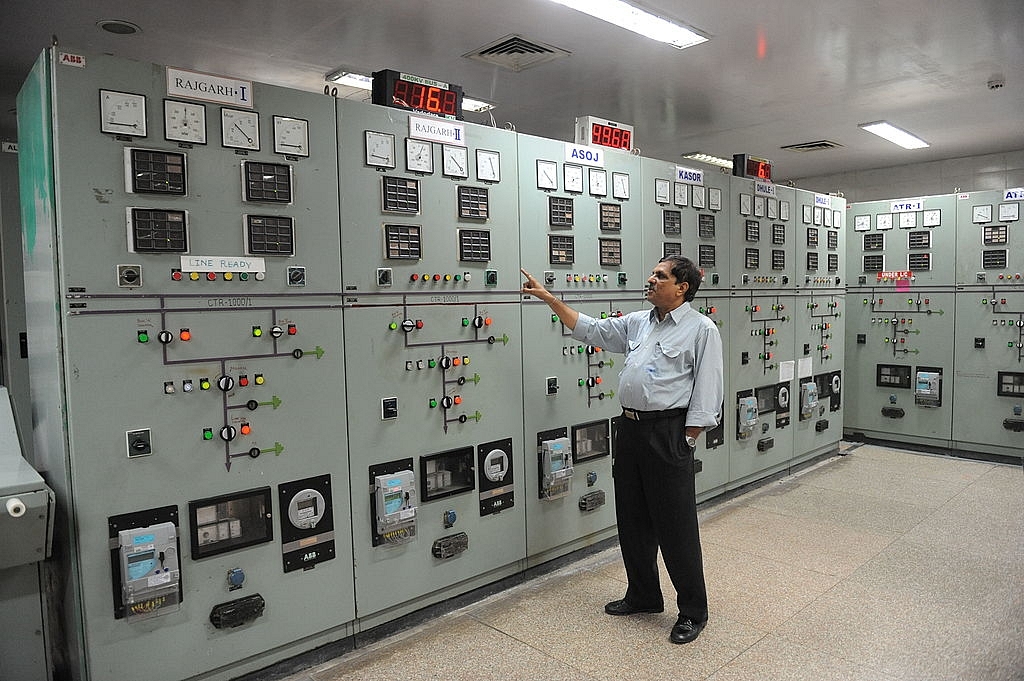Economy
Coal Price Rise Adds To The Woes Of State Power Distribution Firms
- Boosting operational efficiency of Discoms wouldn’t mean much if it is not accompanied by periodic tariff reviews to ensure that they reflect actual costs and not political whims and fancies.

Gujarat State Electricity Corporation Limited deputy engineer Ashokbhai Pandya shows the control panels at the Underground Riverbed Power House of Hydro Power Narmada Project which generates electricity from Sardar Sarovar Narmada Dam. Photo credit: SAM PANTHAKY/AFP/Getty Images)
On 29 May, Coal India Limited increased the price of thermal grade coal, which it supplies to power plants, by about 15 to 18 percent. This may add to the woes of state electricity Distribution Companies (Discoms) that are already struggling to implement the Ujwal Discom Assurance Yojana (UDAY).
While demand for power appears to be slowing down as we approach the end of summer, growth in electricity generation seems to have moderated.
According to rating agency ICRA, the coal price hike may increase the cost of power generation by about nine to 10 paise per unit, with power procurement cost jumping by about six paise per unit for Discoms. The surge in coal prices is not a concern as it is determined by market forces. What is of concern is that the systemic risk of Discoms debt might aggravate.
Ideally, such increases in fuel costs would be passed on to consumers by Discoms under the Fuel and Power Purchase Cost Adjustment (FPPCA) framework. However, the framework has not been implemented in major Discom debt-heavy states like Rajasthan, Tamil Nadu and Uttar Pradesh.
With fuel prices amounting as much as 80 percent of the procurement cost of Discoms, this delay in implementation may prove expensive to those states with ballooning Discom debt.
The states, which have decided to implement the FPPCA, seem to be dragging their feet.
The ‘principles of recovery’ too seem to vary with many states putting in ceilings — discrimination based on source of power purchase and much more.
Without proper and more comprehensive (read: no scope for freebies) implementation of the FPPCA, recovery of regulatory assets and efficiency improvements promised by UDAY, the financial health of Discoms will remain in bad shape in the foreseeable future. In fact, there is a real chance that it may get worse.
The non-implementation of FPPCA in states like Rajasthan and Tamil Nadu is worse given the fact that they have not even filed petitions, for upward tariff revisions for financial year 2016-17, to the state electricity regulatory commissions yet. Overall, the average tariff revisions have been about five percent against the proposed revisions ranging between five percent to 33 percent.
Despite the Power Ministry arguing that tariff hikes alone will not solve the problem when Discoms’ inefficiency is quite high. It appears that the possibility of Discoms returning to a state of good financial health is dependent considerably on such periodic tariff revisions.
When the Power Ministry released the fourth annual integrated ratings for state distribution utilities, only Gujarat received an A+ rating. Two of Rajasthan’s Discoms, along with Tamil Nadu’s Tangedco, got C+. Uttar Pradesh had the unique distinction of having two utilities receiving C, one in C+ and another in B. These ratings accounted for both financial and operational performance. (A+ denotes very high operational and financial performance capability; B denotes below average operational and financial performance capability; C+ denotes low operational and financial performance capability; C denotes very low operational and financial performance capability).
The other part of UDAY — increase operational efficiency — seems to be slowly getting a fillip with the roll out of the plan for India’s first smart grid project in Gurgaon. The Rs 7,000 crore project will be implemented in multiple phases with the first phase costing Rs 1,382 crore. The centre is pumping in about Rs 273 crore. Haryana, despite being so close to Delhi, has a surprisingly high aggregate technical and commercial (AT&C) losses of 34 percent.
With more states adopting UDAY and promising sufficient carrots in the form of increased central funds for Deen Dayal Upadhyaya Gram Jyoti Yojana, Power System Development Fund and other government schemes, it is rational to expect sustained decreases in AT&C across different states. Eastern states like West Bengal which are heavily laden with debt may be more inclined to implement UDAY to boost the power distribution infrastructure.
However, it is important to note that all is not well with the sector, and boosting operational efficiency wouldn’t mean much if it is not accompanied by periodic tariff reviews to ensure that they reflect actual costs and not political whims and fancies.
Also Read:
Introducing ElectionsHQ + 50 Ground Reports Project
The 2024 elections might seem easy to guess, but there are some important questions that shouldn't be missed.
Do freebies still sway voters? Do people prioritise infrastructure when voting? How will Punjab vote?
The answers to these questions provide great insights into where we, as a country, are headed in the years to come.
Swarajya is starting a project with an aim to do 50 solid ground stories and a smart commentary service on WhatsApp, a one-of-a-kind. We'd love your support during this election season.
Click below to contribute.
Latest